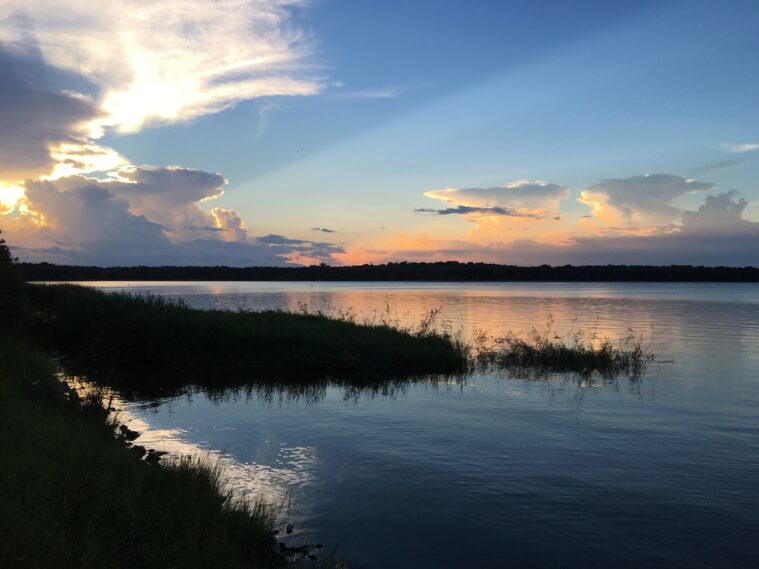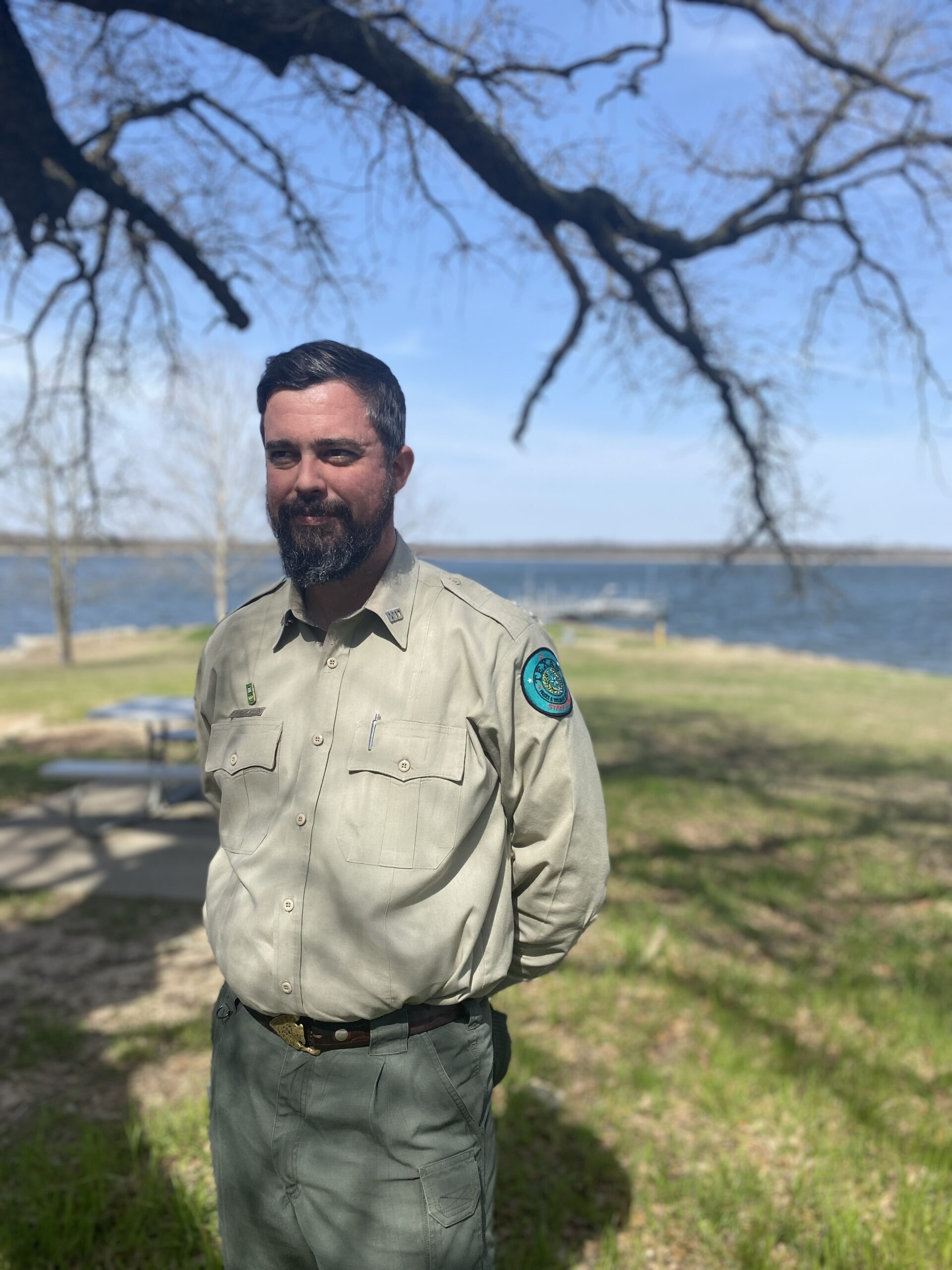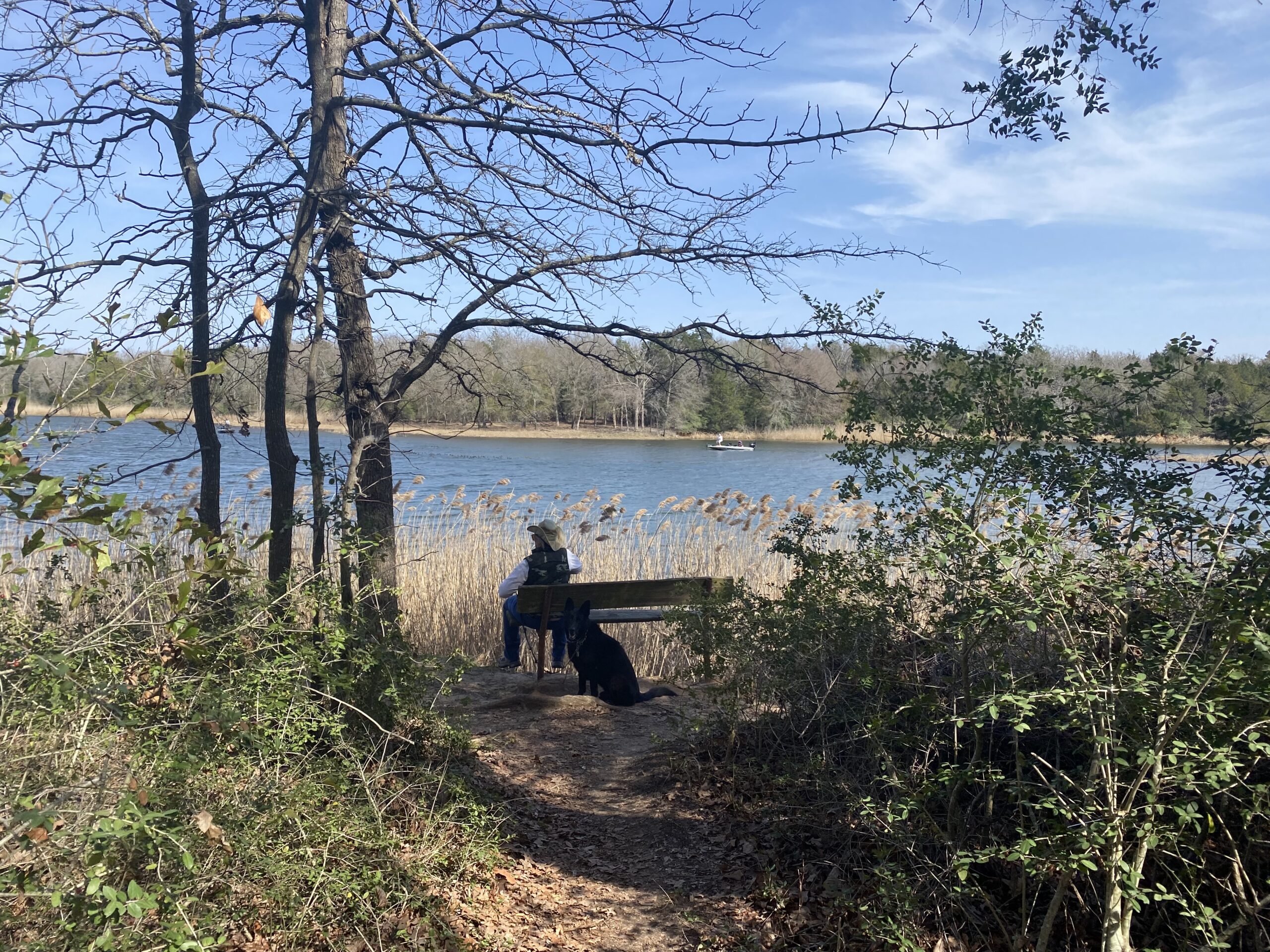Mildred Hempel likes to take photographs. She likes to photograph birds, otters, and even the dragonflies that flit like miniature hawks across the marshes of Fairfield Lake State Park, a meandering preserve 90 minutes southeast of Dallas. “It’s about patience,” Hempel told me. “You sit still and wait, and the dragonflies will fly right back to the same spot.”
Photography is the pursuit of the perfect moment—the image you can freeze and endlessly revisit, undiminished and undimmed. It’s a thing that lingers, a constant in your life. For Hempel, Fairfield Lake State Park has been one of those constants. She first visited as a girl in 1977, back when the coal mine on the other side of the artificial lake still ran, and the Big Brown Power Plant kept the water warm even in December. For nearly 50 years, thousands like her have come, lured by the quiet campgrounds, the packed fisheries, and the miles of trails. Some are local, like Hempel. Others come from further afield: Waco, Dallas, even Oklahoma, making periodic trips. You could do that: pop in once a year, walk the trails, do a little fishing. The park would be there for you. Change as it might with the seasons, it wasn’t going away.
Then, in mid-February, the Texas Parks and Wildlife Department (TPWD) announced that Fairfield Lake State Park—long leased from Irving-based energy company Vistra—had been sold to a private developer. TPWD had 120 days to clear its property off the site before the new owners took over; the park would close February 28, sold to a developer who planned to turn it into a private gated community. The announcement made news throughout the state, sparking petitions, public outcry, and promises of action in the Legislature.
Today, the park’s future remains in doubt. By the time you’re reading this, however, the gates have locked. The facilities are closed, quite possibly forever. And the people who love the park—staff, locals, and visitors—have been forced to say goodbye.
The former Fairfield Lake State Park sits in Freestone County, at the doorstep of East Texas. When I drove out to visit on February 24—four days before it closed—the first dusting of green shoots had appeared on the park’s trees. Heavy winds whipped over the lake, rattling the reedbeds. Choppy waves raced across the shallows.
When I arrived, I hopped in a truck with Daniel Stauffer, the park’s superintendent. Together we drove out to tour the facilities, Stauffer pointing out the day-use sites, campgrounds, and fishing pier.
The lake that gives the park its name is also the key to its origin, Stauffer explained—and, perhaps, its destruction. In 1970, the Dallas Power and Light Company opened a power plant in the county, fed by the lignite coal being strip-mined immediately to the east. The power plant needed a reservoir to keep its equipment cool, so the company dammed the Big Brown and Little Brown creeks to create a 2,400-acre lake. A year later, the site’s owners—which, after the usual corporate merry-go-round of acquisitions and mergers, ended up as Vistra—leased an 1,800-acre lakeside parcel, composed largely of peninsulas, to TPWD at no cost. The state park opened in 1976.

Despite its longevity, the park’s position was always precarious. Rather than being owned by the state or federal government, Fairfield Lake was built atop private land—and that meant its fate was at the owner’s whim. (A few other Texas state parks—including Colorado City State Park and Martin Creek Lake State Park—are subject to similar agreements with Vistra.)
As the decades passed, however, TPWD received continual lease renewals and invested a cumulative $70 million on park infrastructure: staff facilities, campgrounds, roads, electrical, and sewer and water systems. The waters of the lake ran warm enough that people swam and water-skied in the winter, or fished for thriving populations of tropical redfish and tilapia.
“This lake is generational—grandparents have brought kids, who’ve now brought their children,” Stauffer said as we drove. “People have grown up and are now growing their children up in Fairfield Lake State Park.”
Stauffer began working as park superintendent in 2019, when the park’s future was beginning to look a bit shaky. A year earlier, Vistra had closed the power plant and informed TPWD that they weren’t interested in renewing the free lease agreement. Instead, they were putting the whole parcel up for sale. The park’s fate would be in the hands of the eventual purchaser.
“Parks and Wildlife made plays at purchasing the park property itself,” Stauffer said. “But at the time, Parks and Wildlife didn’t have a dedicated revenue stream and we were at the mercy of the Legislature as to what our budget allotted. The revenue we had at our disposal just wasn’t appealing enough to Vistra for them to budge.” Then, the passage of Proposition 5, a November 2019 state constitutional amendment that funnels sales tax revenue from sporting goods to TPWD, created some hope the department could bid competitively.
Vistra amended the lease to keep the park open as long as possible, said company spokesperson Mirana Cohn, avoiding the originally projected October 2020 park closure. Eventually, TPWD and Vistra worked out a deal to end the lease with 120 days’ notice. In the meantime, Vistra posted the land for sale in 2021, to the tune of $110 million. At the time, despite the passage of Prop 5, the state did not submit a formal bid.
Instead, in early 2022, Vistra entered a contract with a new buyer: Todd Interests. A Dallas-based real estate company run by Shawn Todd, Todd Interests is responsible for various high-end developments in downtown Dallas. (The company didn’t respond to requests for comment for this piece.) The company plans to build a private gated community on the park site, complete with multimillion-dollar homes and a private golf course.
“This lake is generational—grandparents have brought kids, who’ve now brought their children. People have grown up and are now growing their children up in Fairfield Lake State Park.”
According to texts leaked to the Dallas Morning News, Texas Parks and Wildlife Commissioner Arch “Beaver” Aplin did make an attempt to purchase the land directly from Todd, but he couldn’t close the deal. Todd offered to sell the parkland to the state, minus the hiking trails on the park’s northern peninsula, for $60 million, with Todd keeping water rights and restricting boating on the lake. Aplin texted back that the northern trails were nonnegotiable.“I just spoke with the Lt Gov and he reminded me I asked him and the leadership for the ok to buy it all, not the park minus,” he wrote, scuttling the deal.
Aplin’s counteroffer was $60 million to Vistra for the whole property, plus a tax incentive—and for Todd to consider the added value of “altruism,” plus naming rights. Aplin’s goal, he told the Dallas Morning News, was to buy the lake outright and expand the park. Attempts to negotiate were reportedly chaotic, Todd Interests and Vistra spokespeople allege, with no formal offers and state officials unable to make up their mind whether they wanted to purchase just the park or the entire property, including the reclaimed mine.
For now, it seems like the state gets nothing. The final notice of lease termination was delivered on February 13, giving TPWD 120 days to remove physical infrastructure like fishing piers, the park’s bird watching platform, and park equipment. From there, TPWD made the decision to close the park on the February 28. “Absent any cooperation or interest in working with us from the developer, we have no other options,” Aplin said in a statement announcing the closure. “Rest assured Commissioners remain committed to working with Todd Interests to maintain this important public asset and grow outdoor recreation in Texas.”
Vistra has taken pains to emphasize that while they value their ongoing relationship with TPWD, the fate of Fairfield Lake is no longer their problem. After nearly half a century of renting land to the state at no cost, “any possible arrangements for the property to serve as a public park in the future will need to be decided between the buyer and TPWD,” said Brad Watson, Vistra’s senior director of community affairs, in a statement to the Texas Observer.
If the development deal proceeds, Stauffer said, the impact on park ecology could be drastic. The preserve occupies a natural crossroads: a triangle of eco-regions that include towering oak trees, pine groves, and open blackland prairie. That mix of habitats shelters an abundance of flora and fauna—protected species like least terns and timber rattlesnakes, charismatic animals like bald eagles and river otters, plus migratory birds, beavers, and deer. Since the power plant closed, the lake has cooled to a more appropriate temperature, its fisheries now producing enormous bass and catfish that fuel fishing tournaments.

“If the developers are able to do what they intend—to … clear land and create pad sites, the landscape would be altered irreparably in a way that would not allow for the wildlife,” Stauffer said. The lake isn’t likely to get off either: Having numerous private homes with verdant lawns—and their attendant pesticides and fertilizers—could end up doing significant damage to the aquatic ecosystem.
There are likely economic impacts as well. During my visit, I stopped in at the Armadillo Emporium, an antiques and crafts store on the main street of Fairfield, the tiny town of 6,000 for which the park is named. The store is one of the community’s largest businesses. Its owner, Julie Emons, sat at the counter unpacking El Arroyo-branded mugs, while her brother Andy—a local artist—sat in a nearby rocking chair. The siblings are fifth-generation Fairfielders: Julie was 3 when the park opened in 1976, and she and her brother have grown up with the park.
Many locals leave Fairfield on the weekends, Julie said. With the mine long-since closed, the lake is pretty much all they have to offer. That morning, five different out-of-town couples had stopped in, from Oklahoma and East Texas, all drawn by the park. “Our business is off of people traveling and touring here. On an average weekend, we get probably 75 percent of our business from campers at the state park,” Julie said. If the park’s turned into a gated development, they’ll lose all that traffic. “All these businesses downtown and especially out toward the lake are going to suffer.”
The closure of the Fairfield park is also a step backward for Texas’ public land stewardship, something the state has struggled with. The nonprofit Environment Texas Research and Policy Center recently found that Texas ranks just 35th in the nation for public parkland, with 54 percent fewer state park acres per capita than Florida. During the early years of the COVID-19 pandemic, statewide park visitation exploded and has yet to drop: This year, the number of visitors to Texas parks is expected to crack 10 million for the first time, and many parks are battling overcrowding. In other words: The state needs more parks, not fewer.
Texas ranks 35th in the nation for public parkland, with 54 percent fewer state park acres per capita than Florida.
“A resource that’s been at the disposal of the people of Texas and [people] of all nationalities—you’re removing that resource from public hands,” Stauffer said. “Losing even just a portion of publicly accessible land is just sad.”
Adding insult to injury, this year marks the 100th anniversary of the Texas parks system, making the loss of any public land a particularly embarrassing blow. As a result, there’s been an unusual scramble on the part of state legislators and politicians to signal support for keeping the park open. “The prospect of a developer taking this treasure out of our state park system is deeply troubling, especially at a time when both the Governor and members of the Legislature have called for the expansion of state parks across the state,” state Representative Trent Ashby, a Lufkin Republican and chairman of the House’s Culture, Recreation and Tourism Committee, wrote in a typical statement. In an interview with the Fort Worth Star-Telegram, Governor Greg Abbott voiced support for keeping Fairfield Lake State Park open, saying, “We’re working with Texas Parks and Wildlife on doing everything we can to preserve the park.”
Republican House Representative Angelia Orr, whose district includes Freestone County, even filed a bill that gives the state the right to acquire the land through eminent domain, citing a vested interest in preserving the park: “This cherished corner of Texas has blessed our local families and countless visitors for generations, and it’s hard to see it lost. As a result, we are now working on legislation to prevent this from ever occurring in any of our other beautiful state parks going forward.” GOP state Senator Charles Schwertner has filed an eminent domain measure as well.
It remains to be seen what legislation might gain steam at the Lege and whether TPWD might manage to negotiate a deal with Todd Interests. Stauffer remains hopeful that some solution can be found, though that may be because the alternative is difficult to imagine.
“It’s an emotional rollercoaster,” he told me as we drove through the park. This land is where he met and fell in love with his wife, another TPWD employee; it’s where he found his calling to work in public lands. “Losing that team, my home, the community of Fairfield, losing the park—it’s heartbreaking.”
“Losing that team, my home, the community of Fairfield, losing the park—it’s heartbreaking.”
Stauffer made the rounds, following the road out of a lowland riparian forest full of muddy creeks and up into a swath of blackland prairie and post oak savannah. Omens of the coming sale were everywhere. A powerboat—“the new owners,” Stauffer said quietly—cruised along the lakeshore near the day-use area, past birders and young mothers out with their children. Stauffer stopped to chat with one retiree, who showed him her watercolors of the lake: She’s on a mission to paint every park in Texas, she told him, and she drove hours to capture this one while there’s still time.
Over the last two weeks of the park’s existence, Stauffer said, they saw an unheard-of level of visitation for the season. Some people came hoping to see the place before it disappears behind a locked gate. Others had been coming for years and wanted to make sure they got a last chance to visit. “Folks are unhappy,” Stauffer said. “But everyone’s been very supportive of the staff and of TPWD’s continued efforts to save the park.”
After leaving Stauffer, I walked down to the park’s birding platform with Hempel, the photographer. We stood there as flocks of teal bobbed amid the shallows of the lake’s far bank, scattering in sudden disarray around a striking hawk. Least terns dove like dropping bombs after fish.
Hempel leaned against the railing, trying to snap a picture of a passing egret. Her impulse to photograph has taken on new urgency: It’s now an effort to preserve what’s on the brink of slipping away, land in common use for almost 50 years enclosed for the benefit of rich out-of-towners. “We’re unhappy about it,” she told me. “It’s our get-out-stress place. My son and sister come out here to go fishing. Our children come out here on outings in the spring. They’re not going to get to do that this year. It’s destroying lives, and it’s destroying our wildlife habitats for a golf course.”
As we talked, a pair of visitors came out to stand with us: Ron Batchelor and Mara Casey, a couple from College Station marking their fourth—and likely last—visit. Together we watched the birds beating their wings against the wind.
“It’s a shame,” Batchelor said quietly. “There’s not much left of these kinds of places anymore. And now this one’s going away, too.”








